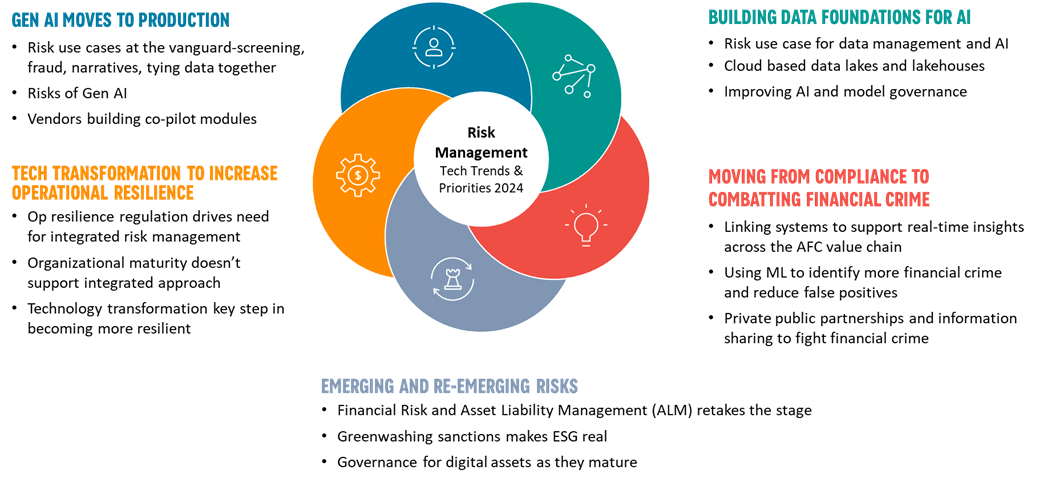In 2024, technological turbulence – generative artificial intelligence (Gen AI), digital asset adoption, increased fraud and cyber risk – will require risk leaders to be more agile than ever. While Risk Executives face this increased uncertainty, their technology priorities for 2024 are clear. Five trends shape where risk executives focus and invest in technology:
1. Gen AI Moves into Production
While few financial institutions have yet integrated Gen AI into their operations, surveys show between 45%1 and 75%2 of financial institution are running Gen AI POCs and intend to move at least one use case into production in 2024. Fraud detection is at the top of the list of use cases being piloted, putting CROs at the vanguard of this new technology. As we move closer to production, risk executives are grappling with the risks in deploying Gen AI, including model bias, hallucinations, false output, and data privacy concerns. They also must evaluate the external risks stemming from Gen AI, including regulatory violations, intellectual property infringement, and empowered bad actors
2. Building Data Foundations for AI
Interest in Gen AI is raising awareness of other advanced AI technologies (machine learning, natural language processing). To feed these models, FIs are using next-generation data management techniques including data fabric and data wrangling to integrate and prep enterprise data. Firms must improve data hygiene and deepen model risk governance
3. Technology Transformation to Increase Operational Resilience
The geopolitical volatility and economic shocks of 2023 have proven the need for decisive, coordinated responses to unforeseen threats. Responses quickly executed across the organization. In 2024, we will see even greater regulatory focus on operational resilience. The UK, Hong Kong and Singapore are already past their initial deadlines, and EU and UK institutions must be fully prepared by Q1 2025. FIs are launching GRC technology transformations to integrate divisional silos and fragmented risk functions.
4. Moving from Compliance to Combatting Financial Crime
In financial crime compliance, the shift from rules-based behavior detection to a pure machine learning based detection is accelerating. Several vendors, including Google, are championing this shift and deploying pure machine learning transaction monitoring systems. Users cite substantial improvements in finding new types and patterns of financial crime, while still reducing the total number of investigations due to 70-80% reductions in false positives.
5. Emerging and Re-Emerging Risk
Enforcement actions by FTC, SEC, and international regulatory bodies against greenwashing emphasize the material threat of misrepresenting environmental, social, and governance (ESG) issues. Climate risk disclosure rules continue to develop worldwide. Also evolving are the regulatory frameworks around digital assets, impacted by chaos at FTX and other exchanges. Chaos has also reared its head as Financial Risk and Asset Liability Management proved problematic at small and medium-sized banks, starting with SVB.








